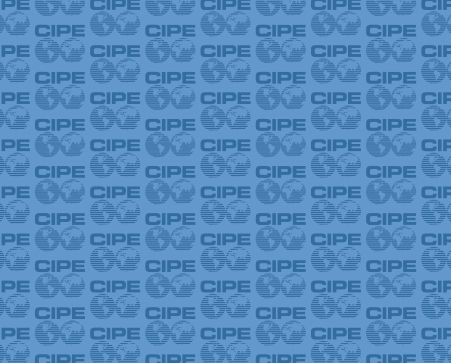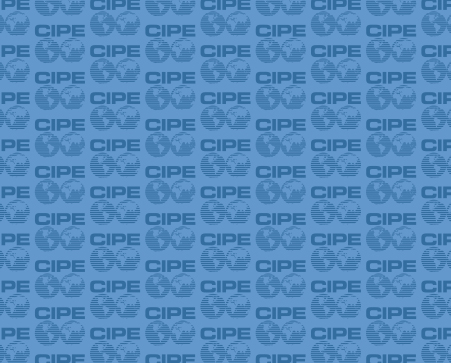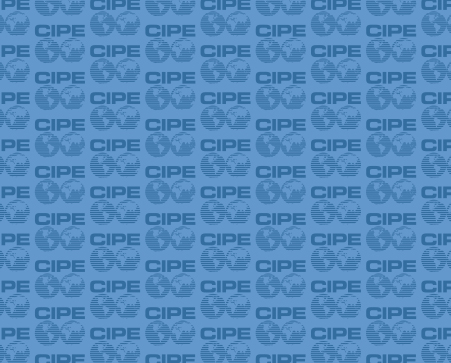
By Dawn Marie Bailey
The following is an interview with William Pawlucy, CIPE Consultant… about his work with Baldrige Performance Excellence Program. Based outside of Washington, D.C., the Baldrige Program helps organizations identify, understand, and manage the factors that determine their success. Through his work with CIPE, Pawlucy has traveled to the Palestinian Territories and Jordan to work with business associations and CIPE partners on improving their organizational and financial sustainability. He is currently a member of CIPE’s team on the Local Enterprise Support (LENS) Project, a USAID/FHI360-funded initiative that works to enhance the effectiveness of Jordanian business support organizations and promote growth for micro and small enterprises. Pawlucy’s engagement with associations through the LENS Project builds on his work with the Baldrige Program; he is developing targeted organizational strengthening programs for several business associations, based in part on the standards of performance excellence used by Baldrige. This article originally appeared on Blogrige, the official blog of Baldrige Performance Excellence Program and has been reposted with permission from the author.
The Baldrige Program has always been fortunate to have engaged ambassadors—many of whom are current or former examiners, judges, or overseers—who carry the Baldrige message of continuous improvement, core values, and a systems perspective, as well as the Baldrige framework itself, with them when they speak in the Unites States and abroad. In Blogrige, we’ve written about such ambassadors traveling to India, China, Southeast Asia, South Africa, and elsewhere. [Please accept this note as a sincere thank you to those folks and others who support Baldrige.]

Below is another story of a Baldrige community member’s travels; this time the story takes place in the Middle East. William Pawlucy served on the Board of Examiners in 2012 and now does work for the Center for International Private Enterprise (CIPE), whose mission is to “strengthen democracy around the globe through private enterprise and market-oriented reform.” Pawlucy and his colleagues have raised awareness of Baldrige resources in places across the region, including Jordan, Lebanon, the Palestinian Territories, and Egypt.
What has been your experience talking about Baldrige in the Middle East?
Talking about Baldrige in the Middle East has found a very receptive audience. All of our work has been (1) promoting democratic and economic reform processes and (2) focused on capacity building and self-sustainability. We have nongovernment organizations (NGOs) that are doing great work but need to be able to think about their processes in establishing a strategic plan, getting strong leadership in place, and using data correctly to increase revenues and relevance while measuring the results.
We are gaining traction and a great interest in the Baldrige approach-deployment-learning-integration (ADLI)/levels-trends-comparisons-integration (LeTCI) approach, which I believe is most beneficial. Many organizations have some sort of defined processes but sometimes miss the LI and never get to LeTCI. That is critical in developing organizations as we work to build their capacity. Our CIPE capacity-building presentations have reached about 40 Middle East NGOs, and each of them now knows about the U.S. Baldrige Program and the benefits of the King Abdullah II Center for Excellence (KACE) in Jordan.
I can’t say enough how much CIPE, the National Endowment for Democracy (NED) and USAID are helping these organizations to move to the next level. I am proud to be there and to utilize my training/experience as a Baldrige examiner. It is all about sharing, and if we can impart the importance of Baldrige not only to the NGOs but to CIPE, NED and USAID, the elements of performance excellence can touch and affect many organizations.
What’s the climate for quality overseas?
I believe that the climate for quality is quite good. In the Middle East, specifically in Jordan, KACE was established to inject performance excellence into Jordanian NGOs. We had the pleasure of having the director of the KACE program, which is very much in line with the Baldrige Program and has about 20–30 employees dedicated to performance excellence, present during one of our capacity-building workshops in Amman. In our capacity-building workshops, we concentrate on providing the tools for NGOs to be self-sustaining by giving them information around growing revenue, members, and their sphere of influence. We cover topics from performance measurement to strategic planning, advocacy, communications, and many other areas. We spend two days with the NGOs in about 8–10 areas to help them grow their organizations. This in turn will also help grow the employment in the country, as strong NGOs then help strengthen small to medium enterprises in Jordan. It is a cascading effect where strong NGOs bring strong growth, and strong growth for Jordan means it can continue to be a stronghold in democracy in that part of the world.
The thirst for the Baldrige Program and its resources is there. The biggest issue is that in Jordan, NGOs are looking for monetary grants or something that goes along with the “prize” for winning the King Abdullah II Award for Excellence, the highest honor. In the United States, if an organization “wins” the Baldrige Award, it is not only a prestigious honor, but the honor provides a great deal of credibility to the organization, in addition to much higher levels of performance. In Jordan, there is a need to go further into the value of the Baldrige Program and how to leverage it for credibility, understanding that the “prize” is the higher standard of excellence that the organization has achieved.
How are Baldrige resources helpful in conducting strategic planning?

The “Baldrige Hamburger,” as I call it, and probably others do as well, shows the seven Criteria areas and how they contribute to processes and results. I always say that you can have good processes, but if you don’t measure and compare the results, then you are only halfway there.
In strategic planning, I ask every organization to define performance measures and targets for each strategy that corresponds to a goal that they have set. This enables the organization to ensure that every strategy is measurable and has accountability to the organization. I know we always talk about SMART goals [S=specific, significant, or stretching. M=measurable, meaningful, or motivational. A=agreed upon, attainable, achievable, acceptable, or action-oriented. R=realistic. T=time-based], but I believe it needs to be deeper, and you need SMART strategies in order to have GENIUS goals.
How has your learning benefited other organizations?
I have one example of this that sticks in my mind. I worked with a state dental society that was failing and almost closing its doors. We embarked on a total organizational improvement plan in many areas of Baldrige. We improved the leadership structure; we put in place a strategic plan; we used data more effectively; and most importantly, we defined performance measures to be achieved over a three-year period. I am so proud of this organization that is one of the few state associations that had an INCREASE in market share. It is a true story of success that is achievable for any organization, as this society had a small budget and limited resources. It came together, both volunteers and staff, to take responsibility for the direction of the organization and did so in a very dramatic fashion. I had an opportunity to refresh their plan last year, and I have to say that they were not aware of the progress they made as they lived it every day, but I was just blown away by what they had accomplished.
The biggest success factor was setting performance measures and targets, and getting commitment from leadership and staff to make it happen. I can’t say it was easy, but they had a focus on their strategic plan through a strategic agenda, which only focused on items that contributed to the goals set by the organization. If there was an item that wasn’t contributing to a goal, it was not a priority and not discussed. Going from a tactically focused organization to one focused on strategies and performance excellence was critical to their success.
What do you feel is the value and personal benefit of being a Baldrige ambassador?
For me, it is giving back. I know I made a considerable investment during my time as an examiner, but Baldrige made an investment in me in providing me with training that was unmatched. I strongly believe that Baldrige can change an organization.
As an ambassador, I want to spread the word that Baldrige is not only an award, it is a way of doing business that will improve your organization if you take the time to make the commitment. It is not about winning an award, it is the journey to performance excellence. If we can touch organizations as ambassadors through the work that we do, we are not only influencing this generation of institutions but future generations that take continuous improvement and make it a habit. Giving back is the ultimate reward, and as ambassadors, I believe we have the responsibility to give back and improve the world in which we live. It is that powerful!
Dawn Marie Bailey is Writer/Editor for the Baldrige Performance Excellence Program.
Published Date: January 05, 2017
